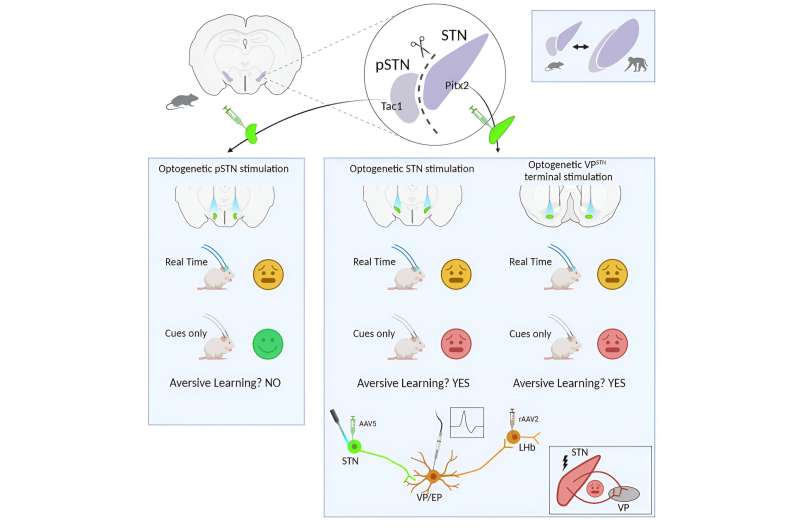This article has been reviewed according to Science X's editorial process and policies. Editors have highlighted the following attributes while ensuring the content's credibility:
fact-checked
peer-reviewed publication
trusted source
proofread
Neural circuit location of strong sense of discomfort found

Researchers have identified a new neural circuit in the brain which produces a strong sense of discomfort when activated. The discovery also allows them to show for the first time that the subthalamic nucleus, a structure in the brain that controls voluntary movements, may also play a role in the development of depression. The results could lead to better treatments for Parkinson's disease.
The study has been published in the journal Cell Reports.
"Our study shows that a specific region of the brain is involved in aversion and avoidance behavior when stimulated. We've studied how mice behave when the subthalamic nucleus is activated using optogenetic stimulation," explains Åsa Mackenzie, Professor at the Department of Organismal Biology at Uppsala University, and the lead author of the study.
The research team previously discovered that mice whose subthalamus is activated seek to get away from the stimulation. In the new study, they were able to show that this behavior is linked to aversion and that the avoidance behavior not only takes place while the subthalamic nucleus is activated, but also that the discomfort lingers in the memory. When the mice were placed in the same environment at a later time, they showed an equally strong avoidance behavior even though the stimulation was now deactivated. The associations were thus strong enough to sustain the behavior.
Aversion is the opposite of reward and plays an important role in making us avoid things that make us feel bad. In humans, it is known that strong activation of the brain's aversion system can lead to depression.
In the new study, the researchers have not only discovered the location in the brain in which the aversion occurs, but have also identified neural circuits originating in the subthalamic nucleus that connect directly to the brain's emotional system, which becomes active during strong feelings of discomfort.
"That the subthalamus gives rise to aversion and avoidance behavior is an important finding for two main reasons. It increases our understanding of the brain's emotional system and how brain activity can lead to psychiatric symptoms such as depression and apathy. Second, it may explain why people with Parkinson's disease treated with deep brain stimulation (DBS) can experience these kinds of side effects," continues Mackenzie.
In Parkinson's disease, the subthalamus is overly active, but stimulating this brain region in severely ill Parkinson's patients using DBS with implanted electrodes "corrects" this and eliminates tremors and other motor problems. The treatment often works very well. However, some patients experience side effects such as severe depression.
"Now that we can show the subthalamus has a direct link to aversion and connects to the depression center of the brain, we can neurobiologically understand and explain these side effects. In addition to Parkinson's disease, subthalamic DBS is also used in cases such as essential tremor and obsessive-compulsive disorder. Our study is basic research and paves the way for improved clinical precision in these treatments. The aim is for DBS to treat the symptoms of the disease without causing severe side effects," says Mackenzie.
More information: Gian Pietro Serra et al, A role for the subthalamic nucleus in aversive learning, Cell Reports (2023). DOI: 10.1016/j.celrep.2023.113328




















